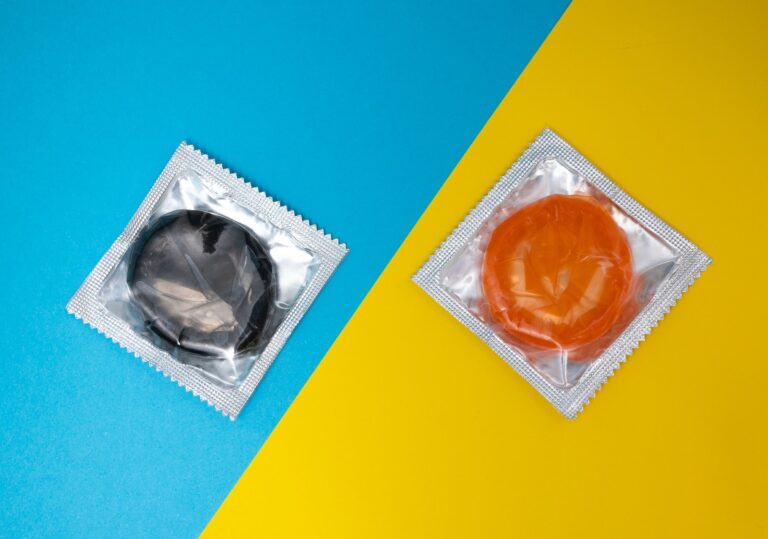Every condom has an expiration date printed on the box or wrapper. Condoms that are not stored correctly or that have expired may not be as safe to use.
How long a condom lasts depends on the material, type of lubrication, and how it is stored. On average, a condom has an expiration date of three to five years – This section is the creation of the portal’s editorial team miss-lingerie-sexy.com.
Latex Condoms
Latex condoms have expiration dates for a reason. Over time, the materials they’re made of degrade and become brittle, reducing their ability to form a protective barrier against sexually transmitted diseases (STIs) and unintended pregnancy. Even if they don’t show signs of wear and tear, old condoms can break or tear more easily during intercourse, increasing your risk for STIs, unprotected pregnancy, and genital ulcer diseases like herpes and chancroid.
The shelf life of a condom depends on the material it’s made from, how it’s stored, and whether it contains spermicide or other additives that shorten its usage lifespan. For example, chemical additives such as spermicide can cut two years off the lifespan of a latex or natural rubber condom.
Also, condoms that are frequently shuffled around in pockets, wallets, purses, and cars can be damaged from the constant friction, especially if they’re exposed to heat. That’s why it’s recommended that you keep condoms in a case or other container that keeps them protected from the elements and away from sharp objects.
Polyurethane Condoms
For people who are allergic to latex or simply prefer a different barrier method for their sex, polyurethane condoms provide a safe option. They are hypoallergenic, don’t fail when used with oil-based lubes and are more resistant to heat damage. However, they are less flexible and don’t stretch as much as latex or polyisoprene, making them more prone to breakage. They also tend to have a tighter fit and may be uncomfortable in some cases.
The type of material a condom is made from influences how quickly it expires. Natural materials like lambskin degrade faster than synthetic materials like latex and polyurethane. Similarly, chemical additives like spermicide shorten the lifespan of both latex and polyurethane condoms by several years. It’s unclear whether lube and added flavorings affect expiration as well, but it’s always best to play it safe by discarding any condoms that show signs of wear or have an unusual odor before their expiration date.
Most condoms will come with an expiration date printed on them, which is required by law to be placed on all sexually transmitted disease prevention products. Many people make the mistake of using condoms past their expiration date, which can lead to a variety of health and safety concerns including unintended pregnancy and sexually transmitted infections. Fortunately, it is simple to avoid this mistake by checking the expiration dates of your condoms regularly and storing them in a safe place away from direct sunlight.
Polyisoprene Condoms
Condoms are one of the most reliable forms of contraception available, but they do expire. Thankfully, every box and individual condom package has its expiration date printed or stamped on it, so you can keep track of when to toss them out. But other circumstances can also shorten a condom’s life span before it even reaches its expiration date, like improper storage.
The material a condom is made of affects how long it lasts. Natural latex and polyurethane condoms without spermicide typically have a five-year shelf life, while those with spermicide have a three-year lifespan. Lambskin condoms, on the other hand, have a shorter lifespan of only three years. The lifespan of a condom can also be shortened by chemical additives, such as lube and flavourings.
Polyisoprene condoms, which are made from a synthetic rubber latex, have an excellent tensile strength, and so are more resistant to wear and tear than other types of condoms. They’re an appropriate alternative for those with latex allergies, and they are just as effective as the original latex condoms in preventing pregnancy and sexually transmitted infections.
No matter what type of condom you use, always check it for signs of damage or wear and tear before using it. If it feels dry, has a foul odor, or you can see holes in the wrapper, throw it out and get a new one. Also, always carry a spare, because a condom can break or be lost during sexual activity.
Natural Condoms
Using expired condoms can leave you vulnerable to sexually transmitted infections (STIs) and unplanned pregnancies. Condoms have expiration dates printed on their packaging and a variety of factors affect how quickly they degrade, including the material they are made from.
A condom’s life span also depends on whether it contains chemical additives like spermicide, which can shorten its lifespan by several years. Also, natural latex, polyurethane and lambskin condoms can become brittle over time and are more likely to break or tear if they come into contact with metal, sharp objects or other condoms, says Nerys Benfield, MD, MPH, a gynecologist at Albert Einstein College of Medicine, Montefiore Medical Center.
The best way to prevent a condom from breaking or tearing is to use plenty of water-based lubricant, especially for anal sex. Avoid body lotions, massage oils or petroleum jelly, which can weaken the latex or other materials in a condom. And if a condom has a foul smell or holes, it is best to throw it away.
Condoms last longer if they are stored in a cool, dry place away from extreme heat or cold and out of the sun. A drawer or cupboard storage box is the best spot. Also, do not store condoms with other items, such as perfume or aftershave, which can degrade the latex.
See Also:



